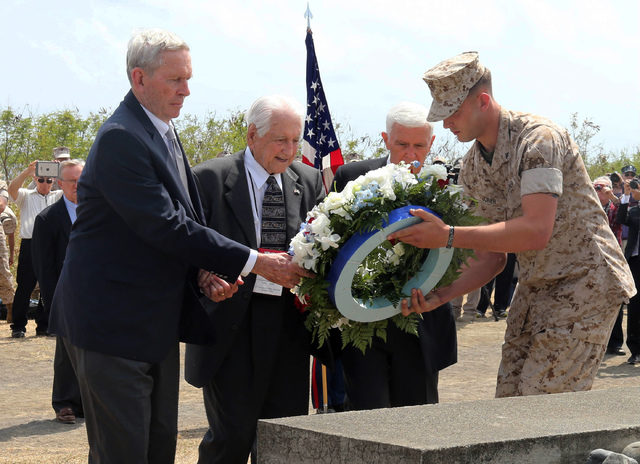IOTO, Japan — Dozens of aging U.S. veterans, many in their early 90s and some in wheelchairs, gathered on the tiny, barren island of Iwo Jima on Saturday to mark the 70th anniversary of one of the bloodiest and most
IOTO, Japan — Dozens of aging U.S. veterans, many in their early 90s and some in wheelchairs, gathered on the tiny, barren island of Iwo Jima on Saturday to mark the 70th anniversary of one of the bloodiest and most iconic battles of World War II.
More than 30 veterans flown in from the U.S. island territory of Guam toured the black sand beaches where they invaded the deeply dug-in forces of the island’s Japanese defenders in early 1945.
They were bused to the top of Mount Suribachi, an active volcano, where an Associated Press photo of the raising of the American flag while the battle was still raging became a potent symbol of hope and valor to a war-weary public back home that was growing increasingly disillusioned with the seemingly unending battle in the Pacific.
For some of the veterans, the return to the island where many of their comrades died, and which is still inhabited only by a contingent of Japanese military troops, brought out difficult emotions.
This was the first time that Japanese Cabinet officials attended the anniversary ceremony, now in its 16th year. And while the presence of veterans able to make the grueling trip has been steadily dwindling, the number of participants — about 500 — was double that of last year because of the significance of the 70th year since Japan’s surrender ended World War II.
The Marines invaded Iwo Jima in February 1945, and it was only declared secured after more than a month of fighting. About 70,000 U.S. troops fought more than 20,000 Japanese — only 216 Japanese were captured as POWs and the rest are believed to have been either killed in action or to have taken their own lives.
The island was declared secure on March 16, 1945, but skirmishes continued. In about 36 days of battle, nearly 7,000 U.S. Marines were killed and 20,000 wounded.
It is to this day considered sacred ground to many Japanese. As a haunting reminder of the ferocity of the fighting, search teams continue to dig up more and more Japanese remains each year — it’s estimated that 12,000 have yet to be found.
Though a tiny volcanic crag, the island — now called Ioto or Iwoto on Japanese maps — was deemed strategically important because it was being used by the Japanese to launch air attacks on American bombers. After its capture, it was used by the U.S. as an emergency landing site for B-29s, which eventually made 2,900 emergency landings there that are estimated to have saved the lives of 24,000 airmen who would have otherwise had to crash at sea.
Twenty-seven Medals of Honor were awarded for action in the battle, more than any other in U.S. military history.
The only surviving Medal of Honor recipient from Iwo Jima, Hershel “Woody” Williams, 91, attended the ceremony. Afterward, he said his feelings toward the Japanese had not changed in the decades since the battle.
“They were just doing their jobs, just like we were,” he said. “We tried to kill them before they could kill us. But that’s war.”





